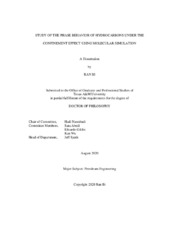| dc.description.abstract | The phase behavior of hydrocarbons in shale reservoirs has garnered increasing attention in the petroleum industry. Significant differences in the phase behavior of petroleum fluids between conventional reservoirs and shale reservoirs have been observed. Because of the existence of nano-scale porous media in shale reservoirs, there are substantial surface–fluid interactions that can lead to a heterogeneous distribution of molecules and an alteration of the fluid phase behavior. In this work, we use Monte Carlo molecular simulation to investigate the confinement effect on the phase behavior of reservoir fluids in different models. Gauge Gibbs ensemble Monte Carlo (gauge-GEMC) and grand canonical Monte Carlo (GCMC) simulations are used to study the saturation pressure, adsorption, desorption, and hysteresis effect of single-component fluids in nanopores. Moreover, a simplified pore size distribution (PSD) model is proposed to investigate the effect of the PSD in shale rocks, and a multi-scale model in molecular simulation is created for the first time to mimic the nano-scale and macro-scale (macro-pores and fractures) porous media in shale rocks. We are also the first to use the Gibbs ensemble Monte Carlo (GEMC) simulation at imposed pressures to simulate the constant composition expansion (CCE) experiment for multi-component hydrocarbon mixtures in the multi-scale pore model. Our results show that 1) the critical temperature, critical pressure, and saturation pressure of single-component fluids decrease in nanopores; 2) the smaller the nanopore is, the stronger the confinement effect becomes and the further the phase diagram shifts; 3) when multiple pores exist in the fluid system, the fluids in larger pores take priority over those in smaller pores in vaporization, while the fluids in smaller pores have priority in condensing; 4) PSD can lead to an overall confinement effect in which it may be possible to use a single-pore model to represent the pore system of a shale sample; 5) in the multi-scale model, the confinement effect will cause a significant difference between the compositions of the fluids in different regions, where the fluid in the bulk region is leaner than that in the confined region and the difference in compositions will increase as the pressure decreases; and 6) the confinement effect in the multi-scale model may cause a significant shift or disappearance of the saturation pressure of the fluid in the bulk region. | en |


